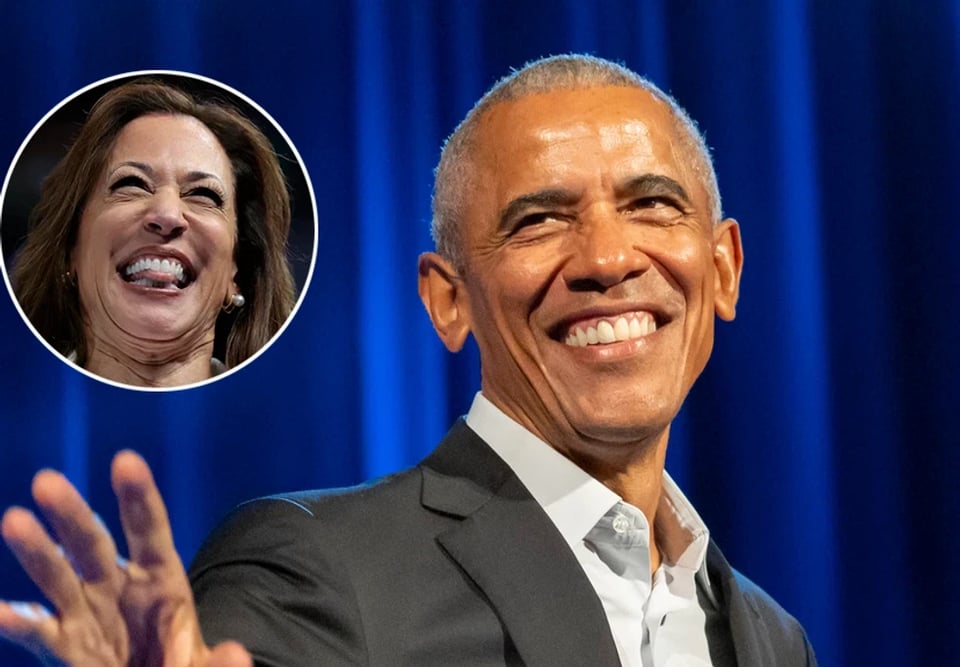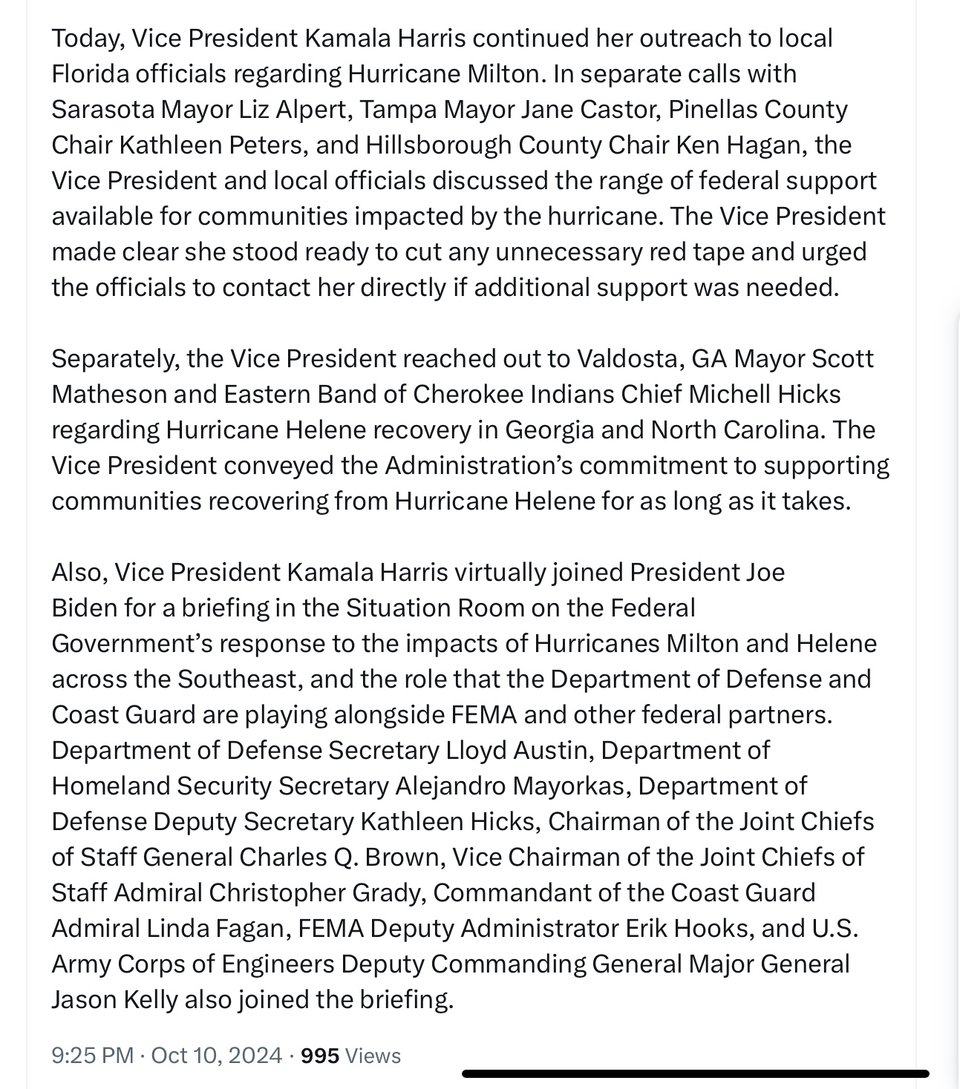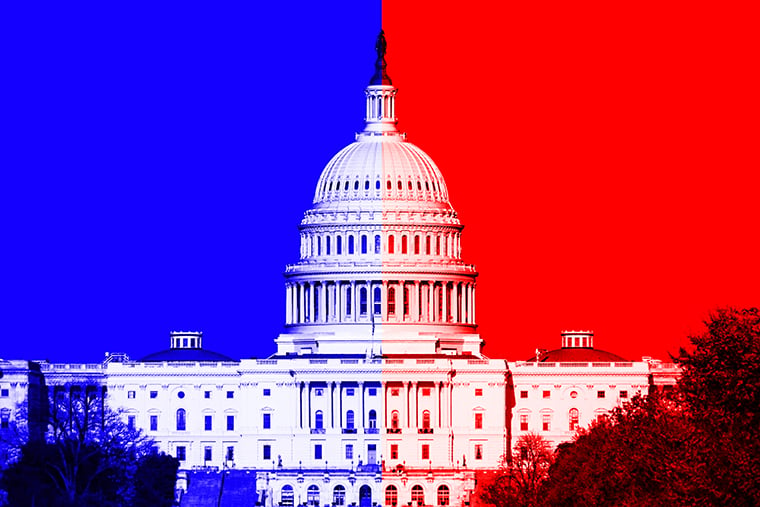Friday, October 11, 2024. Annette’s News Roundup.
Harris Surrogates are everywhere.
Former President Barack Obama traveled to Pittsburgh on Thursday to urge voters there to choose Vice President Kamala Harris in November, aiming a message at one group in particular: Black men.


The decision voters have between the vice president and former President Donald J. Trump, her Republican opponent, “isn’t a close call,” Mr. Obama said as he visited with a group of campaign volunteers and officials at a field office just ahead of his appearance at a Harris rally. His message was for Black male voters whom he said might not be yet on board with Ms. Harris.
Citing “reports I’m getting from campaigns and communities,” he called out what he said was flagging enthusiasm for Ms. Harris compared with the support he received when he was running for the presidency in 2008.
“You’re coming up with all kinds of reasons and excuses,” Mr. Obama said. “I’ve got a problem with that.
“Part of it makes me think that, well, you just aren’t feeling the idea of having a woman as president, and you’re coming up with other alternatives and other reasons for that,” Mr. Obama continued, adding that the “women in our lives have been getting our backs this entire time.
“When we get in trouble and the system isn’t working for us, they’re the ones out there marching and protesting.”
The stern words from the former president were meant to address worrying signs for Ms. Harris, including that her support among Black voters is still lower than what President Biden received when he won the state in 2020, according to a poll last month from The New York Times, The Philadelphia Inquirer and Siena College. Ms. Harris’s advisers and a raft of Democratic strategists believe that if anyone can lift Black voter turnout, it is Mr. Obama.
“He’s got, obviously, tremendous appeal to Black voters,” the Democratic strategist James Carville said. “He has tremendous appeal to suburban whites, which is another big part of the coalition. And he drives Trump nuts.”
Early voting has already begun in Pennsylvania, which Ms. Harris must almost certainly win to defeat Mr. Trump. She holds a narrow lead in the polls there, having overcome the significant deficit she inherited from Mr. Biden. Democrats are hoping for high voter turnout in the state’s biggest cities, Pittsburgh and Philadelphia.
Mr. Obama remains adored by Democrats, making him a natural surrogate for Ms. Harris on the campaign trail. More than 90 percent of Democrats and many independents view him favorably, according to an August survey by The Economist and YouGov — well above other Democrats, including Mr. Biden, Bill Clinton and Hillary Clinton.
Ms. Harris was an early supporter of Mr. Obama, flying to Iowa in 2007 to knock on doors for the junior senator from Illinois when she was the district attorney of San Francisco. (New York Times).
One more thing.
Kamala is always busy.
Kamala Harris has accepted CNN’s invitation to sit for a town hall event Oct. 23 in Pennsylvania, according to her campaign chair, Jen O’Malley Dillon. The town hall event came about after Donald Trump declined to participate in a CNN debate with Harris.

Yes, the Vice President was in Nevada.

At a town-hall event with Univision on Thursday in Las Vegas, Vice President Kamala Harris faced questions on health care, immigration and the economy
Liz Cheney et al are doing their part.
I wish this had been televised or streamed on social media.

Cassidy Hutchinson, Sarah Matthews, Alyssa Farah Griffin, and former Rep. Liz Cheney took the stage last night at a Democracy First event in Glenside, Pennsylvania. (Photo courtesy of Democracy First.)
A Breath of Fresh Air
GLENSIDE, Pennsylvania—Liz Cheney, it turns out, still draws a crowd. Fresh off her Wisconsin endorsement of Kamala Harris last week, Cheney came here last night to bring her message of warning about Donald Trump to the Philadelphia suburbs. Glenside’s Keswick Theatre seats 1,300. She packed the house.
Cheney was appearing alongside three other Cassandras of democracy: Alyssa Farah Griffin, Cassidy Hutchinson, and Sarah Matthews. All served in the Trump administration. Since his attempt to overthrow the 2020 election, all have become ferocious critics.
In a bizarre presidential contest that asks people to weigh questions like “who will commit to the peaceful transfer of power” against questions like “who will bring down the price of eggs,” their message was straightforward: Don’t get distracted.
“His own vice president is not supporting him,” Farah Griffin said. “Multiple chiefs of staff. Former national security advisors. Multiple former Department of Defense heads. Chairman of the Joint Chiefs of Staff. His White House comms director. Deputy press secretary. Another White House comms director. The list goes on. All of us who saw him up close and personal as president, some of the senior-most roles and the most consequential roles, are the people saying he should be nowhere near the Oval Office.”
The event, hosted by the group Democracy First, was in keeping with the Harris campaign’s strenuous attempts to court a small but still significant group: that remnant of Republican voters who have long mistrusted Trump, but who still have not taken the psychological plunge of voting for a Democrat for president.
The latest New York Times/Siena poll suggests this outreach is bearing fruit: 9 percent of GOP voters now say they plan to support Harris, up from 5 percent just a month ago.
Polling from the Democratic-leaning outfit Blueprint, shared first with The Bulwark yesterday, showed that 36 percent of Republicans and Republican-leaning independents who backed Nikki Haley in this year’s GOP primary now intend to support Harris.
In Glenside, though, most who showed up weren’t from this fence-sitting demographic. They were Democrats—well-meaning liberals who wanted to pay their respects to the courage shown in recent years by Cheney and company, who just can’t get their heads around the fact that this is still a close race.
“I’ve been canvassing independents and what [the campaign] thought were persuadable Republicans, and they are so not even on the fence,” attendee Judy Chinn mourned to The Bulwark. “They are voting Republican.”
These interactions have provided the election with an element of surrealism for Democrats. Not long ago, it would have been unfathomable for them to imagine cheerfully attending an event headlined by a Cheney; it would have been remarkable to see so many close aides to a former president warn that he was unfit and unstable; it would have been inexplicable to knock on doors and find that people simply weren’t persuaded by those warnings.
Voters like Chinn are looking for a lifeline back to a politics that makes sense to them. For them, Cheney and company represent just such a lifeline. So despite the speakers’ dire warnings about the looming danger of Trump’s return to power, the atmosphere was remarkably upbeat.
Cheney spoke of Hutchinson’s testimony before the January 6th Committee, noting that Hutchinson was around her own daughters’ age: “I would only hope that if they ever were faced with what you were faced with, that they would conduct themselves with the kind of grace and character and honor that you all have.”
Meanwhile, the younger women spoke of the courage they had derived by looking up to Cheney.
“People have their reasons for not wanting to be more vocal,” Hutchinson said. “It can be scary at times, it can be frightening. But what frightens me more is the possibility of a second Trump term.”
A local voter named Leslie Katz told The Bulwark she saw similarities between the hurdles these Trump alums faced and those other women confront in their professional lives. “That is, not being heard and not being seen as trustworthy and reliable, or being someone that people can actually see as a leader,” said Katz. “And I think the fact that they spoke truth to power and they stood up in the face of all this crap they got and have been getting is I think what a lot of women will identify with. And I think that’s where the appeal is, regardless of what side of the aisle you’re from.”
All this is pleasant, but the niggling question remains: Can the women’s message reach the people that matter—or will the good feelings in the room be the extent of their impact?
Outside, when it was over, volunteers handed out REPUBLICANS FOR HARRIS yard signs to the departing crowd. In a fit of cynicism, I tracked down a few people who accepted them: Are any of you, I wondered, actually Republicans for Harris?
Only one woman, Kathy K.—she declined to give her full name—said she was still a registered Republican. She hoped her party could still recover from Trumpism, although she had only ferocious words for most of its current elected officials: “I think they’re a bunch of spineless men who were cowering in their offices on January 6th, and they all knew what happened. They knew it was a lie. And yet they still want to cling to power and they’re not speaking up.”
As I was speaking with two sign-taking attendees, Lisa Martenson and Jennifer Wiley, a few others walked by and asked about them. “We’re Democrats,” Martenson responded. “We have Republicans in our family.” She was referring to her Harris-supporting Republican husband.
“Oh, good,” the passerby replied. “Will they put those out, do you think?”
“Oh,” Martenson laughed. “He’s putting it out.”
(The Bulwark).
One more thing. Or is she one of the Et Al?
Former WH aide Cassidy Hutchinson: “He sat in the Oval Office dining room, seemingly enjoying what he was watching on TV with his VP in danger, with members of Congress in danger...It was a betrayal of the oath that he swore to the country....a betrayal of the American people." pic.twitter.com/ymxPrTcdC9
— Republican Voters Against Trump (@AccountableGOP) October 10, 2024
This group of voters 👇 should be taken into account too. Haley supporters.
EXCLUSIVE: Poll Finds Large Chunk of Haley Voters Ready to Ditch Trump.
Republican and independent backers of the former U.N. ambassador are far more open to voting Democratic than four years ago.
A SIGNIFICANT CHUNK OF SELF-IDENTIFIED Nikki Haley voters say they will support Kamala Harris for president, according to a new survey shared exclusively with The Bulwark.
If the election were held today, Donald Trump would win just 45 percent of those who backed Haley in the GOP primary while 36 percent said they’d back Harris, the new poll shows, according to the survey of 781 registered Republicans and independents conducted by the new Democratic-leaning polling outfit Blueprint. The poll did not include Democrats or Democrat-leaning Independents who supported Haley.
Trump’s level of support from Haley voters in the poll represents a significant drop in support for Trump, who won those same voters against Joe Biden by 59-28 percent. That 22 percentage point change in preference (from plus 31 percent for Trump in 2020 to plus 9 percent in this survey) could represent a swing of millions of votes.
The findings are among the most substantive analyses of Haley supporters. They come on the heels of a New York Times/Siena College poll showing that Harris has made major inroads among GOP voters, with 9 percent saying they planned to support the vice president, up from 5 percent from a survey last month.
“Between 5 and 10 percent of Republicans and Republican-leaning independents are Nikki Haley supporters,” said Evan Roth Smith, the lead pollster for Blueprint, which conducted the poll between September 28 and October 6. “If Harris can indeed win a third or more of them in the general election, it will provide a boost of a couple percentage points. In such a close race where the margin of victory will be razor-thin, particularly in the swing states, it’s clearly worth pursuing these voters.”
Harris’s campaign has made aggressive efforts to reach disaffected Republicans in the final weeks of the election, leaning on longtime conservatives and former Trump officials as surrogates and featuring them in ads.
Haley supporters are those that the campaign believes it needs to reach. During the GOP primary, a chunk of the electorate consistently supported the former U.N. ambassador over Trump, even after she suspended her campaign. What was less clear was whether they were Democratic-leaning voters who would naturally vote for the Democratic ticket anyway, Republicans who would come home to Trump, or Republicans who would cross the aisle if the former president emerged as the party’s nominee. (The Bulwark)
Compassion? Voting rights?
Not if you are a Republican.
Democrats in North Carolina filed a bill to extend the voter registration deadline and allow absentee ballots a few more days to arrive in light of the devastation wrought by the hurricane. Republicans unilaterally voted it down-- even though western NC is one the most… pic.twitter.com/RhH2Ye0b62
— Brian Tyler Cohen (@briantylercohen) October 10, 2024
You’re not accounting for population density
— Michael Harriot (@michaelharriot) October 10, 2024
In other words, the 2 Democrat strongholds (Asheville & CLT) have more voters than the other 23 counties combined.
They’d rather disenfranchise 300K GOP voters if it stops 500K Dems from votings
That’s how voter suppression works.
According to NPR: "In North Carolina, where the destruction is more severe and the Trump campaign is calling for more voter access, Trump won 51.6% of the affected counties compared to Biden’s 48.4% – 783,330 to 735,009."
— Brian Tyler Cohen (@briantylercohen) October 10, 2024
But your point on voter suppression absolutely stands.…
The real answer in any debate should be What Kind of Country Do We Want!
That is how our world improves.
First came the cliched opinion from the Washington Post Editorial Board.
Harris wants Medicare to cover home care. How will she pay for that? Home health care is a cost burden on families. Harris’s plan could be a cost burden on taxpayers.
Too many American families know the struggle of caring for an aging parent who doesn’t want to leave their home but can no longer fully take care of themself. According to the Niskanen Center, more than 14 million Americans require long-term support services. That number is projected to grow to 24 million by 2030. Government provision of home health-care services is spotty, and family members often take up the slack, a burden that can amount to a full-time job as a home health-care aid, in addition to existing work and family obligations.
Many such caregivers probably took notice when, in a Tuesday appearance on ABC’s “The View,” Vice President Kamala Harris announced a new proposal to have Medicare pay for more home care services.
Unfortunately, her proposal is hazy on the details — exactly what it will cover and how much it will cost taxpayers — and it is these very details that have doomed other such efforts in the past.
Every time Washington has taken a shot at fixing this vexing problem of long-term care expenses — going all the way back to Medicare’s enactment — cost has proved to be the Achilles’ heel. In 1965, the year Medicare was enacted, “it was anticipated a long-term care benefit would be added in short order,” wrote political scientist Robert Saldin, who authored the Niskanen report. That expectation was frustrated by “tough economic realities.”
In 1988, Congress passed the Medicare Catastrophic Coverage Act but dropped an amendment that would have added long-term care coverage. And even the slimmed-down bill proved too much for voters: Seniors wanted protection against extreme medical expenses but were so angry about paying higher premiums that a pack of booing, screaming seniors chased then-House Ways and Means Committee Chair Dan Rostenkowski out of a town hall. Congress repealed most of the program after 17 months.
Finally, in 2010, the Affordable Care Act included a long-term care program called the Class Act, but this program, too, lasted barely a year and a half. The Obama administration gave up on it in October 2011, after determining it could not be simultaneously self-sustaining, financially sound for 75 years and affordable to consumers.
In her appearance on “The View,” Ms. Harris gave an emotional speech about the burdens on caregivers that will resonate with anyone who has been through the experience of caring for an elderly loved one.
For that matter, it could appeal to those who dread consigning an elderly loved one to a nursing home — most of which are already paid for by Medicaid. But while a winning proposal starts with empathy, it can’t be viable without a realistic plan for sufficient benefits, at an economically and politically sustainable cost.
And the outline that the campaign presented in a fact sheet Tuesday was vague on all of those crucial issues. Medicare would evaluate the home care needs of individual Medicare enrollees, the document suggested, then provide appropriate coverage for those with modest incomes, while seniors with higher incomes would share in the cost. That cost could be about $40 billion per year, according to a Brookings Institution estimate cited in the fact sheet. According to the campaign, the money will mostly come from the savings generated by negotiating lower drug prices for Medicare, as well as “implementing international tax reform so that we stop encouraging companies to shift jobs and profits overseas” and savings from sending fewer people to nursing homes.
We have our doubts. KFF, a nongovernmental organization that tracks health trends, reports that “in 2023, the median annual costs of care in the U.S. were $62,400 for full-time homemaker services … $68,640 for full-time home health aide care … and $288,288 for round-the-clock home health aide services.” Long-term care needs vary enormously, and any effort to “tailor” them, as the Harris proposal envisions, would likely involve trade-offs families would resist. Ms. Harris says she wants to expand the caregiver workforce (there’s a shortage now) and raise wages; both might be necessary, but both also push in the direction of higher costs.
Yes, there could be savings from less use of nursing homes, but subsidizing home care will push up demand for that as grateful families rush to get their seniors services they cannot currently afford and substitute subsidized professional care for the unpaid labor they’re now providing. That’s the point, after all: to help seniors live with more comfort and dignity, and to ease the burden on caregivers.
In a policy area where many other politicians have tried and failed to make progress, Ms. Harris deserves credit for restarting a necessary discussion. She would deserve even more credit if her plan were not itself a work in progress.
Then came the smart, thoughtful answer from Mary Trump.
Recently Kamala Harris proposed expanding Medicare to cover the often-crushing burden of long-term home health care. The Washington Post editorial board is deeply concerned about where the money to cover this new program will come from.
Harris wants Medicare to cover home care. How will she pay for that? Home health care is a cost burden on families. Harris’s plan could be a cost burden on taxpayers.
Here’s a question I never hear the corporate media ask: What is the cost of not addressing an issue that affects millions of Americans? In the wake of two devastating hurricanes, Helene and Milton, that’s a question we should be asking in context of climate change: What is the cost of failing to address the increasingly dangerous combination of increasing air temperatures, warming waters, and rising sea levels in terms of loss of human life, destruction of property, and the quality of our existence?
Insurers are pulling out of areas that are at greater risk of damage because of storms like Helene and Milton. What will the burden to tax payers be if people can no longer get property insurance?
Republicans have tried a hundred times (!) to repeal the Affordable Care Act. What if they succeed? That is, what would it cost us if we don’t provide Americans with health insurance? Uninsured people don’t have access to primary care physicians. By the time they seek treatment, they’re often much sicker than they would have been if they had access to preventive care; sometimes they end up going to the emergency room. If they can’t afford to pay those bills, those costs get passed on to the American taxpayer.
Donald Trump, who’s rampage against immigrants has reached a fever pitch, has promised "the largest domestic deportation operation in American history." Leaving aside the moral horror explicit in that proposal, I have yet to see sustained analyses of the ruinous costs of even attempting such an effort. Much the same can be said of tax cuts for the rich, taking healthcare away from tens of millions of people, and failing to address a catastrophic situation that puts all of us increasingly at risk.
We so often worry about the cost of programs that help Americans while failing to factor in the potential gains in terms of opportunities, health, and productivity. It shouldn’t always be—and isn’t always—about money. (The Good in Us by Mary Trump).
Again, there are those who say we are going to lose the Senate.

Are you going to take that sitting down?
Nate Cohn in the New York Times. Why Democratic Senate Control Seems to Be Slipping Away.
A Times/Siena poll shows Jon Tester behind by seven points in Montana, while Colin Allred trails Ted Cruz by four in Texas.
The math for Senate control is pretty simple. For Democrats, it isn’t adding up.
The Democrats have a 51-49 majority in the Senate, but Republicans are expected to flip West Virginia — where Joe Manchin is retiring. Any additional Republican victory in November in seven red or purple states currently held by Democrats would ensure G.O.P. control of the chamber, provided the Republicans hold their own states.
This morning’s New York Times/Siena College poll finds Republicans poised to flip that additional seat: Montana.
Tim Sheehy, a Republican, leads the longtime Democratic incumbent, Jon Tester, by seven percentage points, 52 percent to 44 percent (figures rounded).
Before today, Democrats led nearly every Times/Siena poll of the contested Senate races for months, including in Ohio — where Sherrod Brown led by four points in a state Donald J. Trump won by eight four years ago. A positive Montana result for Democrats would have kept that string going, giving them a path to Senate control. They didn’t get it.
Even so, the Montana result isn’t a surprise. Mr. Tester hasn’t led in a public poll since mid-August, and most of the data hasn’t shown an especially close race. His path to victory — and therefore the Democratic path to Senate control — looked daunting even before he fell behind in the polls, as Mr. Trump won the state by 16 points in 2020. The poll finds Mr. Trump ahead of Kamala Harris by a similar 17 points today.
Without Montana, the Democratic path to the Senate would require flipping a red state. The Times/Siena polls suggest it won’t be easy. On paper, the two easiest options ought to be Texas and Florida, but the polls find the two Republican incumbents ahead — Ted Cruz by four points in Texas, and Rick Scott by nine in Florida.
If these were the final results, it would almost be the end of the line for Democratic Senate hopes. But there’s one last race to be considered — in Nebraska, where an independent candidate, Dan Osborn, has been competitive in the early polling against the Republican incumbent, Deb Fischer. Mr. Osborn said he wouldn’t caucus with either party if he won, which would leave Senate control uncertain.
An unexpected result in a race with an independent candidate can’t be ruled out. As long as the polls show a close race in Nebraska, Democrats can hold out hope (of course, they would also have to win all the races they’re favored in). But it’s worth noting that similar independent efforts in Kansas in 2014 and Utah in 2022 ended with Republican victories. The Times/Siena poll of Nebraska’s Second Congressional District two weeks ago found Mr. Osborn well ahead in the state’s only Democratic district, but not by enough to suggest he was ahead statewide.
Texas over Montana?
With Mr. Tester falling behind in Montana, there’s a case that Texas might just be the Democrats’ better — if hardly good — path to holding the Senate.
While the idea of a blue Texas might seem unimaginable, it’s not necessarily that far-fetched anymore. Mr. Cruz won by less than three points in 2018, and Mr. Trump won by less than six in 2020. If it weren’t for Republican gains among Hispanic voters in recent years, Texas would probably be a tossup in the presidential race this year. And interestingly, Mr. Cruz does fare worse than Mr. Trump among Hispanic voters in the poll.
Still, Mr. Cruz’s four-point lead over Colin Allred — which is in line with other polling — seems close to robust given that the state will probably vote for Mr. Trump in November. And from a financial standpoint, a serious effort to contest the state would cost Democrats hundreds of millions. Perhaps that’s what Democrats should have committed to in a plausibly winnable state, but instead Republicans have outspent the Democrats in Texas so far.(Nate Cohn, New York Times).
Simon Rosenberg and his Hopium Chronicles tell a different story.
There have been good polls out there in the battlegrounds this week if you want to see them.
While Emerson has been a credible pollster in the past, this cycle they are working for right-wing groups and their polls have been running 2-3 points more to the right (red wavy) than other public independent polls. Which is why I want to share their Senate polls this am.

Wow, pretty good numbers for Baldwin and Slotkin you say coming from a pollster who has been leaning right this cycle. Yep. Let’s look at some other recent public polling in the Senate. Let’s start with Wisconsin, Baldwin-Hovde:
53-46 (+7) Marquette
50-43 (+7) NYT
52-47 (+5) Research Co
47-42 (+5) Redfield & Wilton
50-46 (+4) Quinnipiac (yes +4 in Quinnipiac)
50-46 (+4) Emerson
For time and space purposes, I could show you similar data in both the MI and PA Senate races but will get to it tomorrow. It is possible that has GOP advertising ramps up things are “tightening” but the public polling we are seeing in the battleground Senate races remains remarkably encouraging, and I think will matter for Harris in the home stretch.
Is Nate Cohn right? Is the Cook Report which sees the Senate races moving Red? Of is Simon Rosenberg right?
Either way, it is up to us.
We need to deliver for these Democratic candidates who can win.
Democratic Incumbents who can win.
Ohio Senator Sherrod Brown
https://app.oath.vote/donate?p=niemtzow-brown&ref=PPIAM0N1
Wisconsin Senator Tammy Baldwin seeking to defeat Billionaire Eric Hovde who doesn’t even live in the state.
First-time Democratic candidates for the Senate who can win.
Michigan candidate Elissa Slotkin seeking to replace retiring Democratic Senator Debbie Stabenow.
https://app.oath.vote/donate?p=niemtzow-slotkin&ref=PPIAM0N1
Florida’s Lauren Mucarsel-Powell seeking to replace MAGA’s Rick Scott.
https://app.oath.vote/donate?p=niemtzow-murcarsel-powell&ref=PPIAM0N1
Texan Colin Allred seeking to replace Ted Cruz.
https://app.oath.vote/donate?p=niemtzow-allred&ref=PPIAM0N1
Maryland Democrat Angela Allbrooks seeking to defeat Larry Hogan, McConnell’s hand-picked candidate to return the Senate to Republican control. Say NO!!!!!
https://app.oath.vote/donate?p=niemtzow-altman&ref=nybg-oct1
Have you seen how close the polls are??
— Senate Democrats (@dscc) October 8, 2024
Rush a donation to defend the Senate!
Your Daily Reminder
Trump is a convicted felon.
On May 30th, he was found guilty on 34 felony counts by the unanimous vote of 12 ordinary citizens.
The Convicted Felon Donald J. Trump was scheduled to be sentenced on July 11th and September 18th. He will now be sentenced on November 26.
Whoopi wasted NO time going in on the convicted felon White House Bum from Queens. #TheView pic.twitter.com/HWiomux6No
— The Chanteezy Is Real ♉️💛🪷 (@iamchanteezy) October 10, 2024